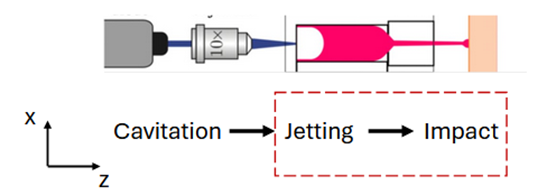Needle-based methods for inoculation and drug delivery are reported as painful by many (Hanberger et al., 2021; Taddio et al., 2022) and can disrupt skin integrity (Cu et al., 2020). Furthermore, targeting the dermis layer for vaccines and drug delivery administration has enhanced the effectiveness of those procedures in some instances in comparison to the widely used intramuscular method (Ita, 2016). However, knowledge of the mechanical behavior of the human skin is lacking due to its anisotropic nature and high level of complexity (Elouneg et al., 2023), hindering the control over injection depth and fluid volume. Based on the previous statements, our team aims to achieve controlled depth and volume delivery of fluids with minimal damage of the skin, using ultrafast jets.

Assignment
1. To fabricate agarose hydrogels, with and without polyamide microparticles, at varying concentrations and controlled volumes in pool reservoirs for jet impact studies.
2. To characterize the mechanical properties of agarose hydrogels, with and without microparticles, across different concentrations.
3. To investigate the impact of jets at varying velocities on agarose hydrogels, with and without microparticles, across different concentrations.
References
Cu, K., Bansal, R., Mitragotri, S., & Fernandez Rivas, D. (2020). Delivery Strategies for Skin: Comparison of Nanoliter Jets, Needles and Topical Solutions. Annals of Biomedical Engineering, 48(7), 2028–2039. https://doi.org/10.1007/s10439-019-02383-1
Elouneg, A., Chambert, J., Lejeune, A., Lucot, Q., Jacquet, E., & Bordas, S. P. A. (2023). Anisotropic mechanical characterization of human skin by in vivo multi-axial ring suction test. Journal of the Mechanical Behavior of Biomedical Materials, 141, 105779. https://doi.org/10.1016/j.jmbbm.2023.105779
Hanberger, L., Tallqvist, E., Richert, A., Olinder, A. L., Forsner, M., Mörelius, E., & Nilsson, S. (2021). Needle-Related Pain, Affective Reactions, Fear, and Emotional Coping in Children and Adolescents With Type 1 Diabetes: A Cross-Sectional Study. Pain Management Nursing, 22(4), 516–521. https://doi.org/10.1016/j.pmn.2021.01.007
Ita, K. (2016). Transdermal delivery of vaccines – Recent progress and critical issues. Biomedicine & Pharmacotherapy, 83, 1080–1088. https://doi.org/10.1016/j.biopha.2016.08.026
Taddio, A., McMurtry, C. M., Logeman, C., Gudzak, V., De Boer, A., Constantin, K., Lee, S., Moline, R., Uleryk, E., Chera, T., MacDonald, N. E., & Pham, B. (2022). Prevalence of pain and fear as barriers to vaccination in children – Systematic review and meta-analysis. Vaccine, 40(52), 7526–7537. https://doi.org/10.1016/j.vaccine.2022.10.026
Contact information
Alejandra Riveros Cortes (r.a.riveroscortes@utwente.nl)
Prof. David Fernandez-Rivas
